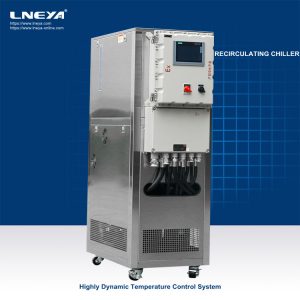Introduction to mixed solution of glycol chilling systems (glycol chillers)
Glycol chillers are industrial refrigeration systems that use a type of antifreeze called glycol, mixed with water, to lower the freezing point in the application of the chilling system.
Glycol is a class of organic compounds that belong to the alcohol family. When mixed with water and pumped through the pipes of a chilling system, glycol serves to slow the rate of freezing. It helps maintain temperature consistency in the application. Some glycol products also work to inhibit corrosion and bacterial growth within the pipes of the chilling system.
Glycol comes in two varieties that should never be mixed together: ethylene glycol and propylene glycol. Both types offer the same relative level of freeze protection. Both also help to guard against corrosion. Some grades of both types of glycol also help to prevent the growth of algae and bacteria within the chiller.
Ethylene glycol is a moderately toxic chemical that has a sweet taste and can be harmful if swallowed. For this reason, it should not be used in potable water or food processing systems when leakage is a possibility. Ethylene glycol has more widespread use due to its lower purchase price. Industrial applications like ice rinks and factories requiring large volumes of the coolant find this to be the most economical choice of glycol.
Mixing Water with Glycol in Your Industrial Refrigeration System
Although you should never mix glycol types there is something that should always be added: water. As mentioned, glycol must be mixed with water to function properly. The type and amount of water to use are key factors to consider.
Ratio of Water to Glycol to Use
Calculating the proper ratio of glycol to water in your chilling system depends on the coldest temperature that the glycol solution will reach during operation. If a chilling system is used indoors where there is no chance of freezing, the amount of glycol needed would be significantly less than required by a glycol chiller used outdoors where temperatures are prone to drop below freezing. Also, if an application requires a very low temperature to operate it should use a glycol mixture similar to that of an outdoor system. In a chilling system, this temperature is normally the saturated suction temperature in the evaporator, and normally this temperature is 10°F below the chiller set point temperature. Using the proper ratio of glycol and water in your chilling system is very important. Adding too much to your chiller system will cause it to become inefficient. However, not enough glycol could cause the system to freeze up, potentially bursting pipes or even rupturing the chiller evaporator.
To learn more about how a 글리콜 냉각기 works, contact LNEYA: sales@lneya.com.
관련 권장 사항
-
Destructive application effect of components in chip temperature measuring device
1006The components can be tested in high-temperature and low-temperature cold sources in the microfluidic chip temperature measuring device. The destructive analysis of components is also an important application, which can measure the design, structu...
세부 정보 보기 -
온도 조절기 시스템을 배치할 때 주의해야 할 사항은 무엇인가요?
970다른 제조업체에서 생산하는 고온 및 저온 서모 스탯 시스템의 크기와 성능에는 특정 차이가 있습니다. 사용자는 구매 후 배치 할 때 배치 방법에주의를 기울여야합니다.
세부 정보 보기 -
500L 반응기 분산형 온도 제어 장치 시스템
839500L 반응기는 산업 제조 및 제약 회사에서 비교적 큰 용량의 반응 용기입니다. 일반적으로 파일럿 규모 또는 중소 규모 생산 단계에서 사용되며 여러 산업 분야에 널리 사용됩니다....
세부 정보 보기 -
재순환 냉각기의 장비 고장 경보에 대처하는 방법
1315What to do if there is a failure and alarm during the use of the recirculating chiller equipment? In order to ensure production, such problems need to be resolved quickly. We must first understand the causes of failures and alarms, and adopt diff...
세부 정보 보기
 LNEYA 산업용 냉각기 제조업체 공급 업체
LNEYA 산업용 냉각기 제조업체 공급 업체













